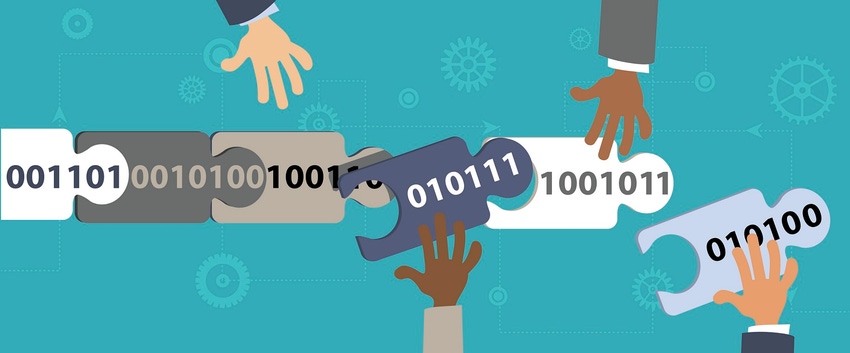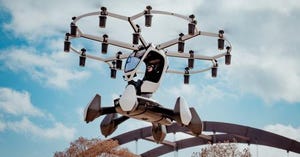In the supply chain industry, the Internet of Things generates data that will benefit from greater centralization and security. Enter blockchain technology.
January 11, 2020

For supply chain managers, tracking and tracing products is a nagging preoccupation. Manufacturers may ship their products across the globe, but they lack key data about shipment location and status as packages move from sea port to port.
This lack of transparency is a hulking challenge that affects efficiency and good decision making, say supply chain professionals.
“Right now, our biggest problem is visibility,” said Milind Balaji, a senior supply chain manager in the pulp, paper and packaging division at an East Coast-based manufacturer. “We don’t know where things are.” In some cases, bad weather or political events may delay product shipments. Or a container may arrive with excessive moisture, damaging the products inside.
If Balaji had greater insight into production location and the state of products, he could route or store shipments differently, he emphasized.
This lack of visibility is a costly handicap. Maritime transport is essential to the world’s economy because more than 90% of the world’s trade is carried by sea. At the same time, the supply chain is incredibly complex. Today’s global trade environment relies on a chain of interdependencies among myriad participants—between 5 and 25 parties—that have a role in some 30 milestones in an international ocean shipment. Guesswork about container location or estimated time of arrival costs the shipping industry as much as $20 billion annually, according to Boston Consulting Group.
At the Port of Rotterdam, the Internet of Things (IoT) addressed these problems, bringing efficiency and transparency to one of the busiest ports in the world. Rotterdam’s waterways handle more than 140,000 traversing ships carrying some 460 million tons of cargo annually.
Data on ships in dock, cranes in the yard and individual containers can now be analyzed to find out about ship and shipment arrivals and so on. As a result, operators are moving 25%–50% more containers per hour than any other of its competitors in northern Europe.
“The IT department has come out of the basement and onto the main floor,” Rudy Muller, senior manager of IT at MVII terminal, said in an article on IoT in maritime.
[IoT World is North America’s largest IoT event where strategists, technologists and implementers connect, putting IoT, AI, 5G and edge into action across industry verticals. Book your ticket now.]
Bringing Efficiency to the Supply Chain with IoT
Today, though Balaji’s team has begun to use trackers on containers to get that critical data on shipment location and state. “Our containers are becoming smart,” he said. “So we can learn not only where it is, what kind of temperature levels or moisture is inside the container. The supply chain is lagging behind other [sectors]. But we’re getting our visibility to the next level.”
Data suggests that the supply chain industry is ready to gain greater visibility into the chain through Internet of Things devices. Among industries spending on IoT technology, the track-and-trace sector is expected to have the largest spending growth—a 24.2% increase —on IoT devices between 2017 and 2023. Inventory and supply chain management will increase spending 20.2% during the same period, according to a Forrester report.
Balaji’s team uses connected sensors in shipping containers to monitor their location. Equally important, shippers can track the state of these containers: temperature, humidity, weight and so forth are easily traceable.
“FedEx can tell you the moment a parcel has been scanned. In our industry we can’t—there’s too many black holes. You have to fix the visibility piece with IoT,” Balaji, said.
It can be costly to use IoT to track shipments. Today, though, real-time tracking of container shipments with IoT is too costly for many companies. “People take for granted that they can find out where a package is,” Balaji explained. “We’re asking the ocean lines, ‘Can we start equipping containers with IoT devices?’ But the ocean liners are saying ‘It will cost you X per day to track.’”
IoT Needs Blockchain for Full Impact on Supply Chain
Still, connected devices can’t help an industry whose data is largely paper based. For tracking and tracing to be fast and accurate, it needs to be digitized. That’s why supply chain observers say that IoT needs blockchain to usher the industry into the modern era.
A blockchain is a distributed ledger that can track a variety of transactions, encrypt the associated data, and also make that data accessible from anywhere [see more on “How Blockchain Works” below.] As a result, a blockchain could not only digitize shipping supply chain data, but also make transactions more secure, standardized and universal—even those without credit cards could participate in blockchain-based transactions.
Early testing of blockchain suggests promise for industries like shipping, which is critical to the supply chain sector. A blockchain-based bill of lading (or proof of shipment) created by Maersk and IBM showed in early tests that administrative costs could be reduced by as much as 15% of the value of shipped goods, thanks to tracking shipping containers and eliminating paper documents. The elimination of paper could create savings of $1.5 trillion globally.
Balaji said that digitization would bring speed and efficiency to his company’s operations.
“It will quicken so much of the way we do business,” he said. “We spend an inordinate amount of time on documentation. We have entire departments working on it—it’s mind-blowing. Trade itself will get faster.”
Balaji also noted that blockchain would ultimately be an enabler for IoT. Today many manufacturers may not be willing to pay for truly real-time IoT data and analytics and instead opt for data that is less granular. But with blockchain, Balaji predicted, data will become not only digitized but also less costly and more accessible. Ultimately, he said, IoT needs blockchain so that more enterprises can get more access to this data in truly real time.
“I can’t think of a bigger thing to come to our industry than digitization of the documentation in shipping,” he emphasized.
But it’s going to take time for blockchain to become more efficient and mature. Today, validating a transaction among all the blocks in the chain is time-consuming, requires lots of compute power and is untrusted (its sister technology, bitcoin, has fits and starts and as well as security breaches). I think it’s going to be at least five years until blockchain matures,” Balaji said.
But blockchain could help solve some data standardization and accessibility challenges that have plagued IoT.
“Just like the Internet gave people a common platform to talk on,” Balaji prognosticated, “blockchain will give us a common platform to exchange goods on.”
How Blockchain Works
Blockchain has matured in a variety of industries, from financial services to supply chain. A blockchain works this way: When a new transaction takes place, every computer in the blockchain network records the information into a database, or digital ledger, of sorts. That timestamped transaction is combined with others to form a block, also timestamped to prevent overwriting or duplication.
As a block is added to the larger chain, it includes a “hash”— a unique string of characters—to make the chain virtually immutable and unbreakable. A hash from one block is then added to the data in the next block. When the next block goes through the hash function, a portion of it is woven into the new hash.
Each of these blocks includes a timestamp and a link to the previous block of the chain and the transaction is processed only after several confirmations by the network; this process ensures that every transaction follows the rules of the network. After the information is stored in the block, it cannot change or be deleted unless the subsequent blocks are also modified and the majority of the network accepts the change. Therefore, user’s interference in the blockchain looks impossible and the system becomes completely waterproofed.
Experts agree that blockchain is poised to fundamentally change the supply chain. “As companies seek to exploit the benefits of greater levels of digitalization, new and innovative technologies, such as blockchain and artificial intelligence (AI)/machine learning, can potentially and significantly disrupt existing supply chain operating models,” says Christian Titze, vice president and analyst, Gartner in a 2019 piece on trends in supply chain.
About the Author(s)
You May Also Like

.jpeg?width=700&auto=webp&quality=80&disable=upscale)
.png?width=700&auto=webp&quality=80&disable=upscale)


.png?width=300&auto=webp&quality=80&disable=upscale)
